
FS-2023-0653 | June 2023
Keys to Identifying Palmer Amaranth and Waterhemp
Introduction
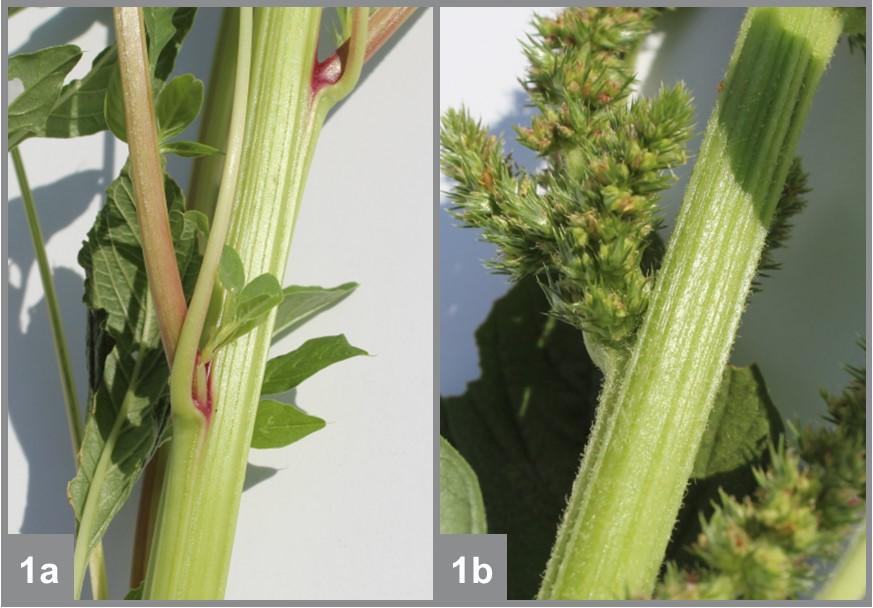
Palmer amaranth and waterhemp are two members of the pigweed family that are listed as noxious weeds by the Code of Maryland Regulations (15.06.05.03). Their status as noxious weeds requires Maryland landowners to manage these species on all types of land. These two species are resistant to multiple herbicide groups, and are well adapted to conditions in the Mid-Atlantic area. Once established in agronomic and vegetable fields they can be very difficult to control. Therefore, early identification is especially important. Three other pigweed species that are commonly found in Maryland – spiny amaranth, smooth pigweed, and redroot pigweed – are similar in appearance to Palmer amaranth and waterhemp. These species also pose problems in agronomic and vegetable crops, but their control is not mandatory. Being able to accurately identify these five species will help landowners with their management efforts.
Identification
The following botanical characteristics will help differentiate the five species listed above in the field:
Stems
Look for the presence of small hairs on the stem of the plant you need to identify. The stems of Palmer amaranth, waterhemp, and spiny amaranth do not have hairs (Figure 1). Smooth pigweed and redroot pigweed have visible hairs even when the plants are about two inches tall (Figure 2).

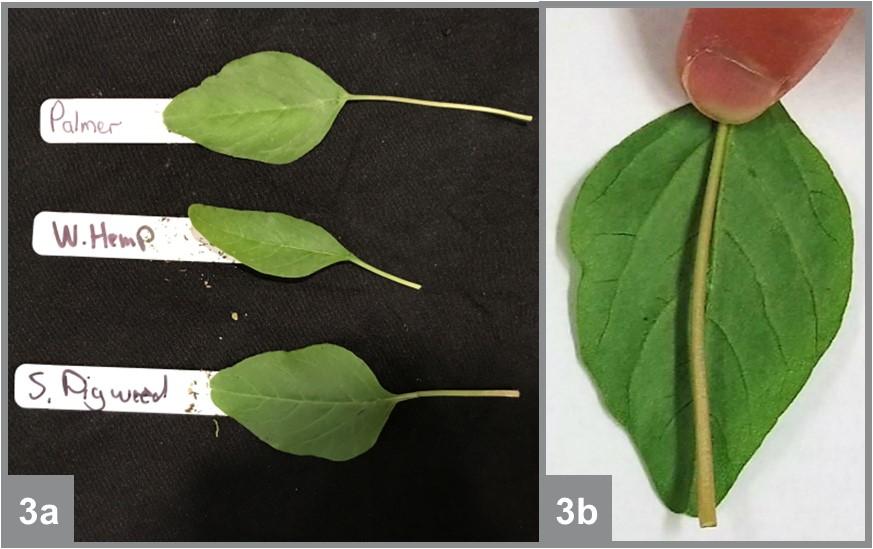
Leaves
Compare the length of the leaf petiole (the stalk that attaches the leaf blade to the stem) to the length of the leaf blade. Mature leaves of Palmer amaranth will have longer petioles than their respective leaf blades when compared to those of other pigweed species (Figure 3). When folded over, the petiole of mature Palmer amaranth leaves will be as long as or longer than the leaf blade itself. Note: longer petioles can also be a feature of spiny amaranth; be sure to look for spiny amaranth’s distinctive (0.2-0.4 in.) spine at the base of the leaf (Figure 4).
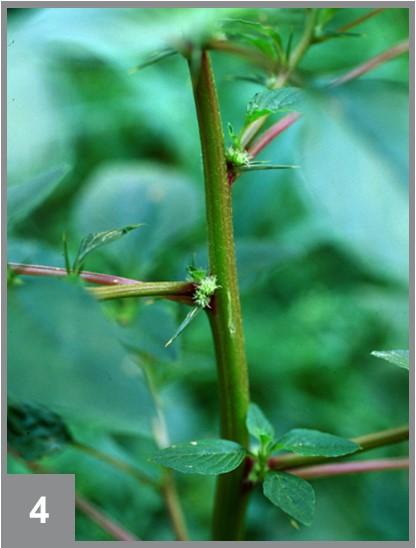
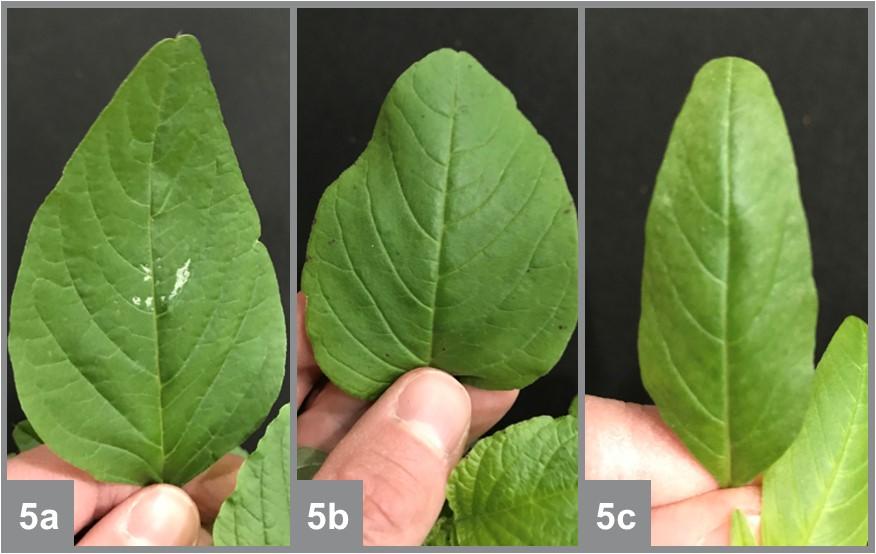
These species are also be differentiated by their leaf shape. Compared to other pigweed species, waterhemp leaves are long and linear (Figure 5). Palmer and spiny amaranth leaves are typically egg- to diamond-shaped, and redroot and smooth pigweed leaves are oval- to egg-shaped. Redroot and smooth pigweed leaves will also have wavy edges (Figure 6). Palmer amaranth leaves have no hairs on them, but the presence of a single hair in the notch of the leaf tip of some Palmer amaranth plants may be used to help differentiate this species from waterhemp (Figure 7). Note: a V-shaped watermark is often found on Palmer amaranth leaves, but this feature can also be present occasionally on redroot pigweed and spiny amaranth (Figure 8).
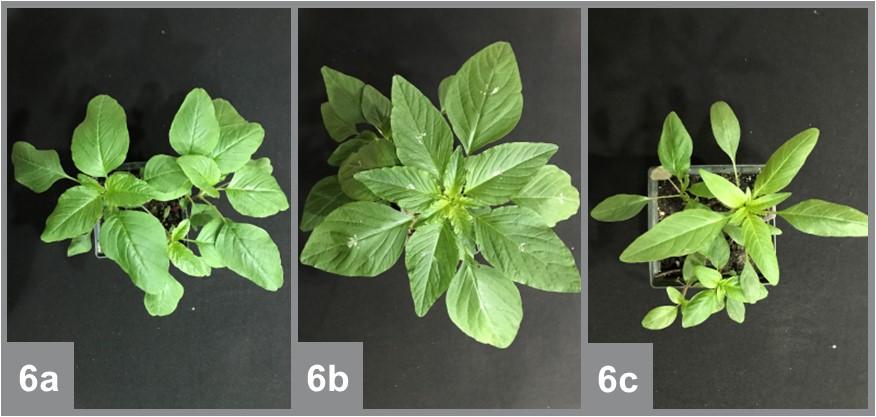
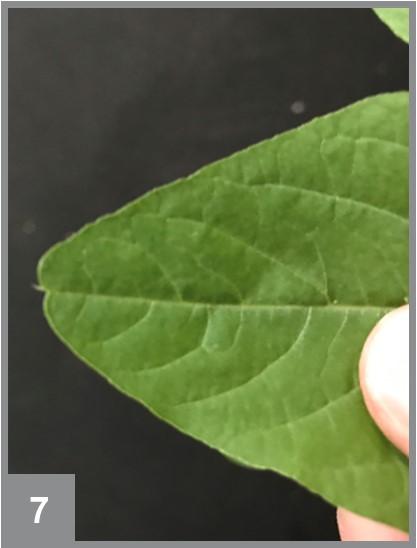

Flowers
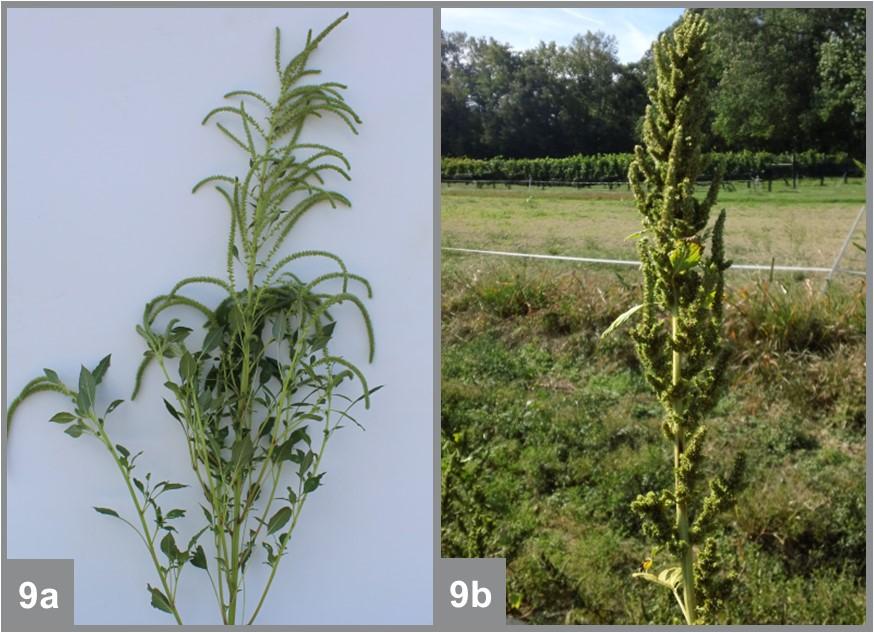
Palmer amaranth plants produce the longest flower spikes among these five pigweed species (2 to 3 ft.; see Figure 9). Palmer amaranth and waterhemp have separate male and female plants. Male plants only produce pollen and female plants only produce seed. The seed-producing female flowers of Palmer amaranth are tightly clustered and contain sharp bracts (0.12-0.24 in.) at the base of the flowers located in the leaf axils, whereas male flowers can appear yellow, are soft, and will release pollen when touched. Female waterhemp flowers do not have sharp bracts and are less tightly clustered than that of Palmer amaranth. In contrast, spiny amaranth, smooth pigweed, and redroot pigweed contain both male and female flowers of on the same plant. Male spiny amaranth flowers can be found at the terminal spike, and female flowers are located on the stem axils. Male and female flowers of both redroot and smooth pigweed are produced in the terminal flower spikes. The flower spikes of redroot pigweed will have a short, stubby appearance, whereas smooth pigweed flower spikes are more slender and less compact.
Proper identification is important for planning an effective herbicide program. In the Mid-Atlantic region, researchers have documented populations of Palmer amaranth and waterhemp that are already resistant to glyphosate (Group 9) and ALS-inhibiting herbicides (Group 2); however, resistance to at least six other herbicide groups has been confirmed in other populations throughout the United States (Heap 2023). As a result, managers should implement plans to prevent these species from developing resistance to additional herbicides. Important keys for managing Palmer amaranth and waterhemp include:
- Starting clean with tillage or a good preplant herbicide program;
- Applying residual (preemergence) herbicides with multiple, effective modes-of-action at planting. Residual herbicides that effectively control smooth, redroot, and spiny amaranth will also control Palmer amaranth and waterhemp;
- Applying effective postemergence herbicides before the plants are 3 to 4 inches tall; and include an additional residual herbicide to extend control until crop canopy closure;
- Scouting often for potential escapes after each herbicide application; and
- Being mindful that Palmer amaranth and waterhemp are often introduced and moved on farm equipment such as combines and balers. Use harvest weed seed control tactics to avoid spreading seed. For small to moderate infestations, harvest a field’s clean areas first. Follow this by harvesting the infested areas, and then clean the combine thoroughly, before moving to other non-infested fields. If a field is heavily infested with Palmer amaranth or waterhemp, consider whether or not the crop will provide sufficient yield to offset costs.
For more information on additional ways to manage these weeds, consult the resources found on the GROW (Getting Rid Of Weeds) website and search for “Palmer amaranth” or “waterhemp.”
Certain pigweeds such as Palmer amaranth and waterhemp must be managed to prevent their spread and the resulting negative impacts on Maryland agriculture. Many pigweed species can appear similar to the untrained eye. Becoming familiar with these species allows for earlier detection, and as a result, improved management practices.
- Heap, I. The international Herbicide-Resistant Weed Database. http://www. weedscience.org. Accessed May 4, 2023.
KURT VOLLMER, PH.D.
kvollmer@umd.edu
BEN BEALE
bbeale@umd.edu
This publication, Keys to Identifying Palmer Amaranth and Waterhemp (FS-2023-0653) is a part of a collection produced by the University of Maryland Extension within the College of Agriculture and Natural Resources.
The information presented has met UME peer-review standards, including internal and external technical review. For help accessing this or any UME publication contact: itaccessibility@umd.edu
For more information on this and other topics, visit the University of Maryland Extension website at extension.umd.edu
University programs, activities, and facilities are available to all without regard to race, color, sex, gender identity or expression, sexual orientation, marital status, age, national origin, political affiliation, physical or mental disability, religion, protected veteran status, genetic information, personal appearance, or any other legally protected class.
 English
English العربية
العربية Български
Български 简体中文
简体中文 繁體中文
繁體中文 Hrvatski
Hrvatski Čeština
Čeština Dansk
Dansk Nederlands
Nederlands Suomi
Suomi Français
Français Deutsch
Deutsch Ελληνικά
Ελληνικά हिन्दी
हिन्दी Italiano
Italiano 日本語
日本語 한국어
한국어 Norsk bokmål
Norsk bokmål Polski
Polski Português
Português Română
Română Русский
Русский Español
Español Svenska
Svenska Català
Català Filipino
Filipino עִבְרִית
עִבְרִית Bahasa Indonesia
Bahasa Indonesia Latviešu valoda
Latviešu valoda Lietuvių kalba
Lietuvių kalba Српски језик
Српски језик Slovenčina
Slovenčina Slovenščina
Slovenščina Українська
Українська Tiếng Việt
Tiếng Việt Shqip
Shqip Eesti
Eesti Galego
Galego Magyar
Magyar Maltese
Maltese ไทย
ไทย Türkçe
Türkçe فارسی
فارسی Afrikaans
Afrikaans Bahasa Melayu
Bahasa Melayu Kiswahili
Kiswahili Gaeilge
Gaeilge Cymraeg
Cymraeg Беларуская мова
Беларуская мова Íslenska
Íslenska Македонски јазик
Македонски јазик יידיש
יידיש Հայերեն
Հայերեն Azərbaycan dili
Azərbaycan dili Euskara
Euskara ქართული
ქართული Kreyol ayisyen
Kreyol ayisyen اردو
اردو বাংলা
বাংলা Bosanski
Bosanski Cebuano
Cebuano Esperanto
Esperanto ગુજરાતી
ગુજરાતી Harshen Hausa
Harshen Hausa Hmong
Hmong Igbo
Igbo Basa Jawa
Basa Jawa ಕನ್ನಡ
ಕನ್ನಡ ភាសាខ្មែរ
ភាសាខ្មែរ ພາສາລາວ
ພາສາລາວ Latin
Latin Te Reo Māori
Te Reo Māori मराठी
मराठी Монгол
Монгол नेपाली
नेपाली ਪੰਜਾਬੀ
ਪੰਜਾਬੀ Afsoomaali
Afsoomaali தமிழ்
தமிழ் తెలుగు
తెలుగు Yorùbá
Yorùbá Zulu
Zulu ဗမာစာ
ဗမာစာ Chichewa
Chichewa Қазақ тілі
Қазақ тілі Malagasy
Malagasy മലയാളം
മലയാളം සිංහල
සිංහල Sesotho
Sesotho Basa Sunda
Basa Sunda Тоҷикӣ
Тоҷикӣ O‘zbekcha
O‘zbekcha አማርኛ
አማርኛ Corsu
Corsu Ōlelo Hawaiʻi
Ōlelo Hawaiʻi كوردی
كوردی Кыргызча
Кыргызча Lëtzebuergesch
Lëtzebuergesch پښتو
پښتو Samoan
Samoan Gàidhlig
Gàidhlig Shona
Shona سنڌي
سنڌي Frysk
Frysk isiXhosa
isiXhosa